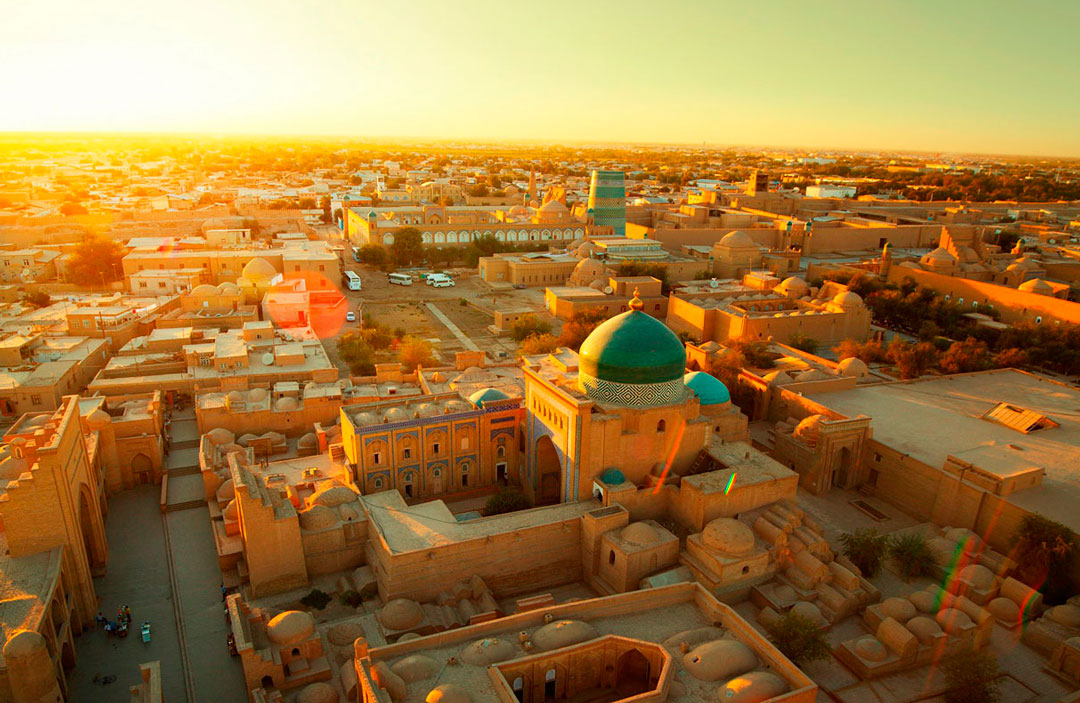Khiva (Uzbek: Xiva, Хива; Russian: Хива) is a town in the western province of Khorezm in the Republic of Uzbekistan.
Along with Samarkand and Bukhara, Khiva is an important and often overlooked historical site on what was once the Great Silk Road (Uzbek: Buyuk Ipak Yol'i). Famous for its long and brutal history as a slave trading post sandwiched in between the vast Kyzylkum and Karakum deserts, Khiva is now a quiet, sleepy oasis that awaits busloads of tourists instead of caravans of captives. It's difficult to imagine what exactly ancient Khiva was like, considering the historical areas were restored to a scrubbed and squeaky-clean look by the Soviets in the 1970s. However, the clustered array of mosques, madrassahs and tiled minarets within a area of less than 3km give you a sense of how crowded and bustling this town must have been throughout its history.
Khiva is divided into two distinct sections; one being the older, museum-like Ichon-Qala or Itchan Kala (literally: within the wall) where striking examples of Islamic architecture were built over the span of 600 years; and the modern Dichon-Qala (literally: outside the wall) where both the majority of the population live and where all of the modern buildings exist, but glimpses of Khiva's greatness as a center of Islamic power still linger. Today, the entire city is home to about 40,000 people. It's a quick 35km from the regional capital of Urgench and a mere 5km from the border of Turkmenistan.
Urgench (Uzbek: Urganch, Урганч, ئۇرگەنج; Persian: گرگانج, Gorgånch/Gorgānč/Gorgânc) is a city in western Uzbekistan. The population of Urgench on April 24, 2014 was approximately 150,110, an increase from 139,100 in 1999. It is the capital of the Khorezm Region, on the Amu Darya River and the Shavat canal. The city is situated 450 km (280 mi) west of Bukhara across the Kyzylkum Desert.
The history of the city goes back to the second half of the 19th century. The city should not be confused with the similarly-named city of Konye-Urgench (also known as "Old Urgench" or "Gurgench") in Turkmenistan. The city of Old Urgench was left after the Amu Darya river changed its course in the 16th century, leaving the old town high and dry and without water. New Urgench was founded by Russians in the second half of the 19th century at the site of a little trade station of the Khanate of Khiva.
Modern Urgench is a Soviet-style city with cotton motifs adorning many objects, from street lights to apartment houses. Of note is a monument to the twenty Komsomol members killed by Tekke basmachi on the banks of the Syr Darya in 1922, and a large statue to Muhammad al-Khwarizmi, the 9th century local mathematician who revolutionised algebra, outside the Hotel Urgench. A flat, drab place, Urgench is the main gateway for tourists to Khiva 35 kilometres (22 mi) to the southeast, whose old city, known as Itchan Kala, is a UNESCO World Heritage Site.









